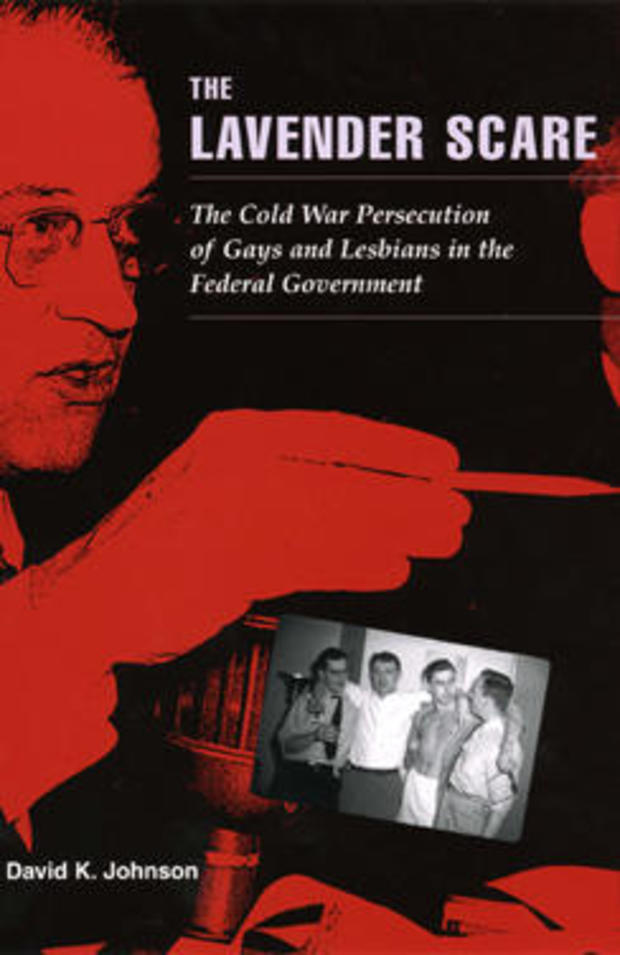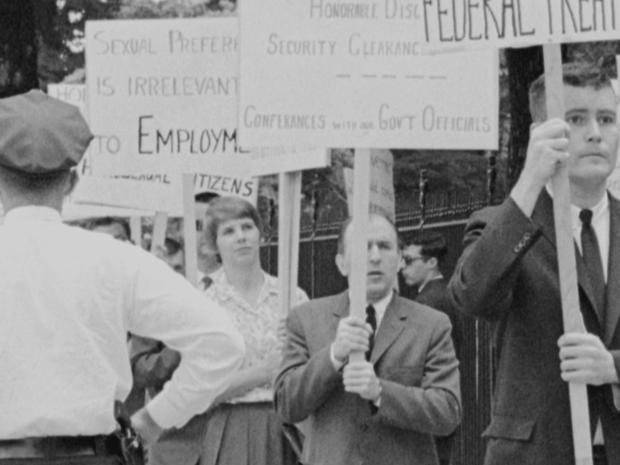How The Federal Government Purged Gay Employees (Lavender Scare)
You may have heard of the "Red Scare" of the 1950s – the fear stoked by Republican Senator Joseph McCarthy that Communists had infested the federal government. Accused State Department employees would be interviewed for the purpose of acquiring information concerning others. "That was the technique that was used by the government: grab one person, and then get that person to inform on other people," said filmmaker Josh Howard.
But a panic of a different shade led to a much wider purge of gay employees. "Homosexuals must not be handling top-secret material," McCarthy said. "The pervert is easy prey to the blackmailer."
The panic long outlasted McCarthy's tenure.
 |
| CBS News |
David K. Johnson is the author of the definitive history of what's come to be known as the "Lavender Scare." He defined it as "a fear that permeated Cold War political culture, this fear that gay people were a threat to national security, that they had infiltrated the federal government, and that they needed to be systematically removed from government service."
The rooting-out of homosexual employees became official policy with an executive order signed by newly-elected President Dwight D. Eisenhower in 1953.
"This is a guy who understood firsthand a real threat," said correspondent Mo Rocca. "I mean, he's the Supreme Allied Commander in World War II, so you would think he would understand a real threat."
"Well, I think he did," said Johnson. "I think he probably didn't see this as a real threat, but he saw that it won elections."
"That it was expedient, politically?"
"It was part of their campaign, right. 'Let's clean house.' Let's get rid of all these people."
Howard, formerly of CBS News, has produced and directed a new documentary, soon to air on PBS, about the Lavender Scare. He said there's a good reason probably you don't know about this chapter in history.
"The Lavender Scare happened in private," Howard said. "The people who were being fired didn't want to tell their closest friends and relatives why they had been fired, because they wanted to stay in the closet.
"If you were found out to be gay in those years, your life was essentially over. You were shunned by society. You were shunned in the workplace. It's the reason people were in the closet in the 1950s."
Even in private homes, gay people were not safe from investigators.
Bob Cantillion, a Navy serviceman, was told to report to the police station for interrogation. He recalled in the documentary, "At Christmastime, some friends were having a party. Somebody must have tipped them off that there was a party where gay people were going to be.
"I freely admitted that I was gay. And then they said, 'We also want five names of other people you know.' So, I searched my mind and I gave them the names of five people I thought would be least hurt. My impression was that after I named the five names, they'd let me go and nothing else would happen after that. But then we were all discharged."
Rocca asked, "Was there any due process? I mean, could you call a lawyer?"
"You could not bring in an attorney, no, wasn't allowed," said Johnson.
"You were just forced to answer yes or no, to confess?"
"Right. The security officials boasted that gay people very easily confessed and told the truth. What they don't talk about is the fact that they essentially blackmailed people. They threatened to tell their families. So, a lot of gay people quietly resigned."
Johnson estimates that between 5,000 to 10,000 people were fired or resigned, and we'll never know how many didn't pursue their dreams for fear of exposure.
Navy Captain Joan Cassidy came from a family of proud veterans. She had a shot at becoming the first female admiral. "I couldn't do it, I just couldn't do it," she said. "It was too big a chance to take. So, I had to give up the possibility of admiral because I was gay and because I wasn't sure I could hide it well enough."
Other stories ended in the worst possible way. Drew Ference, the son of immigrants, spoke five languages and was serving in the U.S. Embassy in Paris when investigators confronted him with evidence that he was gay. Shortly after confessing, he killed himself.
He wasn't the only one.
Johnson said, "I saw lots of news reports, newspaper reports, of single young men, government employees, who committed suicide in Washington for no apparent reason."
"No one was defending gay people," said Howard. "The Democrats stayed away from this issue. At the time, the ACLU believed it was perfectly legitimate for the government to fire homosexuals as a threat to national security."
The persecution of homosexual public servants gave rise to the gay rights movement in the pugnacious person of Frank Kameny, a Ph.D. from Harvard and an astronomer with the U.S. Army Map Service. He was fired in 1957 for being gay. In the documentary he declared, "To the best of my knowledge and belief, I was the first person to fight back out of all those large number of people who were fired in the '50s."
According to Johnson, Kameny says that "this issue is not about national security, it's not even about morality. It's about civil rights. He creates this new rhetoric. He calls himself and his colleagues in the group 'homosexual American citizens,' and that you can't forget either part of that."
In 1963, he became the first openly gay person to testify on Capitol Hill.
Then in 1965, he organized picket lines in front of the State Department and the White House. He told CBS News then, "Every American citizen has the right to be considered by his government on the basis of his own person merits as an individual."
"Those folks were very courageous," Johnson said. "It had never been done before, and they were scared to death."
But the discriminatory policy continued. In 1980, Jamie Shoemaker worked for the National Security Agency as a linguist. When asked what kind of security clearance he had, Shoemaker said, "Very high. Probably more than the president has, actually. You might be surprised."
One day, his supervisor told him that security wanted to question him: "And the first thing they said was, 'Mr. Shoemaker, we understand you're leading a gay lifestyle.' And I said, well, I didn't think I was leading it, but I said, 'Yes. I am.' And immediately they took my badge off. And they read me my rights."
And so, he called Frank Kameny. Shoemaker recalled, "He yelled at me and said, 'Why did you let them take your badge? And why didn't you shut your mouth?'"
Six months later, with Kameny's help, Shoemaker made headlines when the agency allowed him to keep his job, and his security clearance.
In 1995, after 42 years, the last vestiges of Eisenhower's executive order were finally overturned, when President Bill Clinton signed an executive order rescinding the policy.
Rocca asked, "How many gay federal employees actually spied for foreign governments?"
"There was not a single example of a gay man or a lesbian who ever submitted to blackmail by a foreign agent, not a single one," said Howard.
In 2009, Frank Kameny was back at the White House, this time invited by President Barack Obama for a ceremony extending the rights of gay federal employees.
Kameny died in 2011, not long after being interviewed by Josh Howard, who said there are still lessons to be learned from Kameny's courage:
"I grew up in a time before there was marriage equality and before Stonewall," Howard said. "So, I'm in some ways envious of younger people, that they are growing up in a more tolerant society. But I also hope that they understand that equality is not a given, that there are people who fought and sacrificed for those accomplishments."
To watch a trailer for the documentary "The Lavender Scare" click on the video player below.


Comments